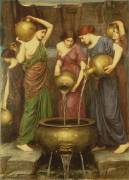Shop art print and framed art Hésiode et la Muse by Gustave Moreau
Subjects : History, Mythology
Keywords : muse, bare, lyre, poet, star
(Ref : 15770) © RMN (Musée d'Orsay) /Hervé Lewandowski
Customise
Your art print
Hésiode et la Muse OF Gustave Moreau
The artwork
Hésiode et la Muse
Hesiod and the Muse is a painting by the French Symbolist painter Gustave Moreau, produced in 1891, the last year of his life. Also spelt Hesiod and the Muse. Oil. The subject is taken from the ancient Greek poet Hesiod and the Muses, goddesses of the arts who are said to have inspired his poems. The subject is one of Gustave Moreau's most prolific motifs, and this work is a colourful representation of Hesiod as a poet and Musa as his teacher and guide. It was created for Count Henri Delaborde, painter, art critic and secretary of the Académie des Beaux-Arts. It is now part of the collection of the Musée d'Orsay in Paris.
According to the preface to The Theosophical Chronicle of Hesiod and The Work and the Day, Hesiod was not originally a poet, but a young man who lived in Askra, a cold village in Boiotia, where he had been farming and raising livestock since his father's time. But one day, while Hesiodos was tending sheep at the foot of Mount Helikon, the Musas, goddesses of poetry, appeared to him and gave him a laurel wand, imbuing Hesiodos with the voice of the gods so that he could sing poems to their glory. Later, after becoming a poet, Hesiodos travelled to Chalkis, a city on the island of Evia, to take part in the funeral contest of King Ampidamas, where he won the singing competition and received a prize of one ding. On his return, Hesiod dedicated it to Musa on Mount Helicon.
Hesiod, wearing a green laurel wreath on his head, strums the strings of a large lyre as [...]
This artwork is a painting from the modern period. It belongs to the symbolism style.
« Hésiode et la Muse » is kept at Musee d'Orsay, Paris, France.
Find the full description of Hésiode et la Muse by Gustave Moreau on Wikipedia.



































